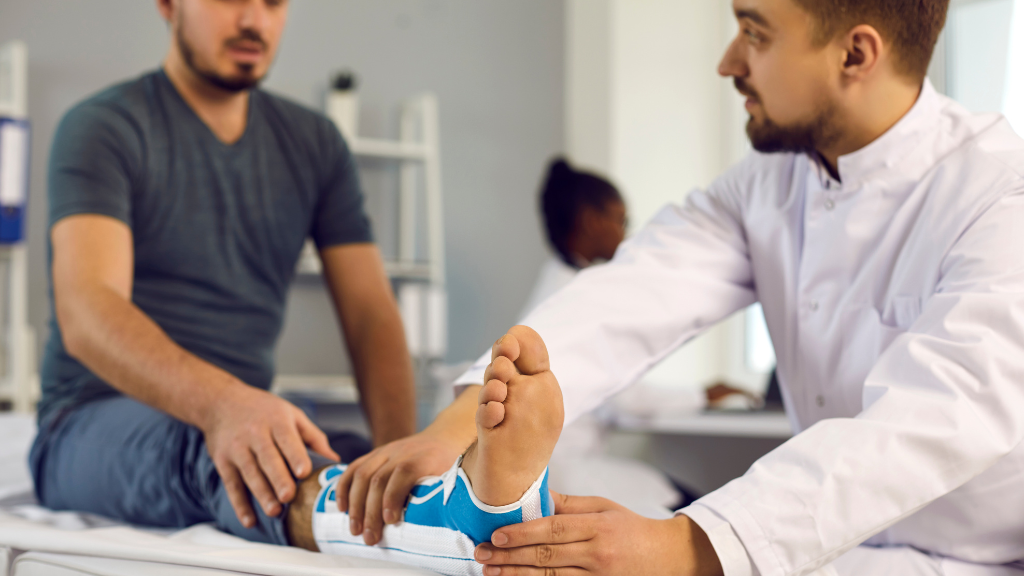A fracture can suddenly change your life, restricting movement and causing pain and uncertainty about your recovery. While medication and immobilization are crucial first steps, long-term healing and restoration of function depend significantly on orthopedic physiotherapy. At Dr. Vigil’s Advanced Orthopedic Physiotherapy, Acupuncture, and Rehab Clinic in Mira Road, we specialize in orthopedic physiotherapy for post-fracture care, empowering patients to reclaim their lives with confidence and strength.
Understanding Fractures and Bone Healing
A fracture is a break or crack in a bone, caused by trauma, overuse, falls, or medical conditions like osteoporosis. Bone healing is a natural process, but it needs proper alignment, rest, and a gradual return to activity. Without focused intervention, complications such as joint stiffness, chronic pain, muscle atrophy, or improper bone healing may arise.
The Role of Orthopedic Physiotherapy
Orthopedic physiotherapy is the gold standard for post-fracture rehabilitation. It goes far beyond pain relief; its core objectives are to:
- Restore mobility after fracture
- Accelerate bone healing physiotherapy
- Strengthen affected muscles and joints
- Enable a safe and sustained return to daily activities
The Stages of Post-Fracture Rehabilitation
1. Early (Acute) Phase
Right after the fracture is stabilized (either by casting or surgery), the focus is to:
- Manage pain and swelling using modalities like ice/heat therapy, ultrasound, and TENS
- Begin gentle movements to maintain circulation and prevent joint stiffness (ankle pumps, finger flexion, etc.)
- Educate the patient about bone healing physiotherapy and safe movement to avoid further injury
2. Sub-Acute Phase
As the bone heals, orthopedic physiotherapy evolves to include:
- Isometric muscle contractions to prevent muscle wasting without stressing the bone
- Gradual increase in joint movement to prevent contractures
- Simple weight-bearing as guided by the physician and physiotherapist, this is critical for both bone healing and stimulating new bone growth
3. Functional Recovery Phase
In this stage, the patient’s mobility after fracture is more actively restored using:
- Manual therapy, including soft tissue release and joint mobilization, to improve flexibility and relieve tension or adhesions
- Strengthening exercises using bands or light resistance to regain lost muscle mass
- Balance and proprioception training especially after lower limb fractures
- Gait retraining to ensure proper walking technique and confidence
4. Return to Normal Activities
The final step focuses on advanced techniques that prepare the patient for real-world demands:
- Higher resistance and impact exercises (when the bone is strong enough)
- Sports rehabilitation, if required
- Ergonomic and postural training for safe return to work and hobbies
How Orthopedic Physiotherapy at Dr. Vigil’s Helps
At Dr. Vigil’s Advanced Physiotherapy Clinic, personalized care ensures the best outcomes for post-fracture rehabilitation. Our orthopedic physiotherapy services, available at Mira Road and Bhayandar, are open 7 days a week, supporting every stage of your recovery journey. Here’s how we enhance your healing:
- State-of-the-Art Machinery: We use advanced technology for faster recovery, pain management, and bone healing physiotherapy.
- Manual Therapy & Mobilization: Expert hands-on techniques accelerate healing, reduce stiffness, and break down internal adhesions around the fracture site.
- Tailored Exercise Programs: Each patient receives a plan suited to their specific fracture location, stage of healing, and functional goals, key for restoring mobility after fracture.
- Patient Education: Understanding your injury and recovery timeline empowers you to take an active role in post-fracture rehabilitation.
- Pain & Swelling Management: Modalities such as hot/cold therapy, ultrasound, and electrical stimulation are used as needed for bone healing physiotherapy and comfort.
- Fall & Re-injury Prevention: Our team emphasizes safety, teaching you proper movement patterns so you avoid unnecessary strain while your bone continues to heal.
Bone Healing Physiotherapy: Key Techniques
Here are some hallmark methods your physiotherapists at Dr. Vigil’s may use for bone healing physiotherapy and post-fracture rehabilitation:
- Manual Therapy: Mobilizes soft tissue and joints for improved flexibility and reduced pain.
- Progressive Strength Training: From isometrics in the acute stage to resistance bands and weight-bearing exercises as healing allows, optimizing both muscle strength and bone density.
- Range of Motion (ROM) Exercises: Essential for ensuring mobility after fracture, preventing joint stiffness, and maintaining function.
- Gait & Balance Training: Especially vital after leg fractures to restore normal walking patterns and reduce fall risks.
- Electrotherapy & Ultrasound: Support bone healing by reducing inflammation, improving circulation, and accelerating tissue repair.
- Education: Promotes confidence and adherence to rehabilitation plans outside the clinic.
Benefits of Orthopedic Physiotherapy After a Fracture
The advantages of orthopedic physiotherapy for post-fracture rehabilitation are life-changing:
- Quicker bone healing: Active therapies promote better circulation and stimulate osteogenesis, directly aiding bone healing physiotherapy.
- Restored strength & function: Prevents atrophy, restores movement, and gives you back your independence.
- Reduced complications: Prevents conditions like deep vein thrombosis, chronic pain, improper healing, and long-term stiffness.
- Enhanced mobility after fracture: Ensures you regain full range of motion and functionality in the affected limb.
- Psychological benefits: Rehabilitation fosters confidence, provides goals, and eases the anxiety that often follows a traumatic injury.
Why Early and Ongoing Physiotherapy Matters
Scientific research emphasizes the need for prompt and sustained orthopedic physiotherapy during post-fracture rehabilitation. Waiting too long can result in muscle atrophy, joint contractures, and even poor bone healing. Early mobilization (starting gentle, guided movement as soon as safely possible) is crucial for optimizing both mobility after fracture and total recovery.
Why Choose Dr. Vigil’s for Post-Fracture Rehabilitation?
- Expertise: Dr. Vigil’s clinics are led by specialists in advanced orthopedic physiotherapy care, serving Mira Road and Bhayandar with dedication and compassion.
- Comprehensive rehabilitation: From injury to full recovery, every step is supported, whether your need is bone healing physiotherapy, expert advice, or cutting-edge modalities.
- Accessibility: Open all week, ready to serve busy families, working professionals, and athletes alike.
Conclusion
Fractures are challenging, but you don’t have to face recovery alone. With skilled orthopedic physiotherapy at Dr. Vigil’s Advanced Physiotherapy Clinic, you can look forward to faster healing, reduced pain, and a return to full, active living. By tailoring post-fracture rehabilitation to your unique needs, prioritizing bone healing physiotherapy in Mira Road, and helping you maximize mobility after fracture, we walk with you every step of the way on your journey to recovery.
If you or a loved one is navigating life after a fracture, book an appointment today and experience Dr. Vigil’s difference. Move better. Heal faster. Live pain-free.
Frequently Asked Questions
Who needs orthopedic physiotherapy after a fracture?
Every fracture, regardless of age or bone involved, benefits from post-fracture rehabilitation to restore strength, flexibility, and function.
Can you regain full mobility after a fracture?
With consistent orthopedic physiotherapy, most patients achieve excellent mobility after fracture, barring severe or complicated breaks.
How long does bone healing physiotherapy take?
This varies depending on injury, age, general health, and adherence to your personalized program. On average, post-fracture rehabilitation spans from several weeks to a few months with ongoing exercises for long-term function.




